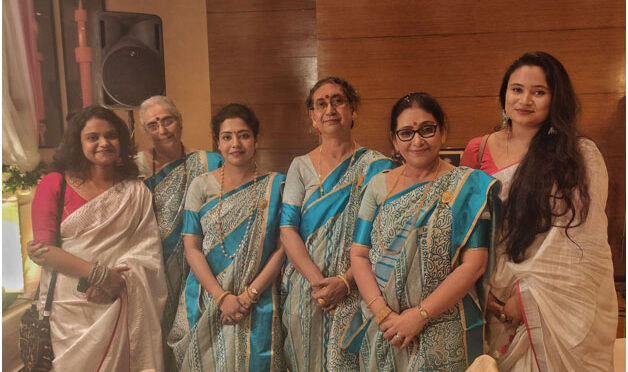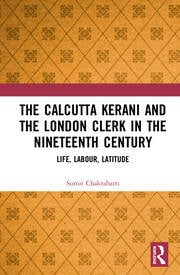Interview of an eminent female priestess – Dr. Nandini Bhowmick
Posted on : April 13, 2023Author : Preeti Saha

Priesthood has been always kept aside for the upper caste men. Women of even Brahmin families were denied the right to priesthood. But today women are breaking the stigma of being impure and taking up priesthood as a profession despite all oppositions from the society. An Indologist, a scholar in Sanskrit, and an eminent female priestess, Dr. Nandini Bhowmick, hails from Kolkata. She is one of the founding members of Shubhamastu, an organization of lady priests. Together with three other female priests, Bhowmick is on a mission to bring about a revolution in this patriarchal society of the 21st century. Not only has she challenged the norms by taking up priesthood, she has also brought about significant changes in marriages by battling the age-old wedding rituals which reek of women’s derogation and subordination. She sees marriage as a partnership rather than a patriarchal institution of exercising dominance.
- What made you take up this work or profession?
- I was a student of Lady Brabourne College. A professor in the Department of Sanskrit, Gauri Dharmapal was one of our most favorite teachers. She was an eminent Vedic scholar and a writer in children’s literature. I came to meet her several years after I had graduated and was pursuing professorship. She suggested that Ruma (my teammate, who was also her student) and I take up priesthood. She told us that she had published a book on the subject and would want us to carry forward her legacy. This was the time when my elder daughter’s wedding was approaching. So, this proposal caught my interest.
- How long have you been practicing? Do you have a team/association of priests or do you work on your own?
- Initially Ruma and myself used to conduct marriages based on Gauri Dharmapal’s script which focused on simplifying and shortening the rituals so that the common masses can relate to and understand it. We would hardly get one or two marriages in a year or even two. After Didi (addressing Gauri Dharmapal) passed away, we felt the need to revamp the script. Since I am a theater artist and I belong to a cultural background I decided to develop priesthood as a form of art. My interest in Indology as a subject helped me undertake extensive research to develop a new script. We wanted to transform the marriage ceremony into a spectacle which would be performed as a cultural event, but imbibed with utmost spirituality. In this way, keeping the crux of the original script intact, Ruma and myself evolved a beautiful script and decided to include two vocalists (Semanti and Poulomi) in our team. This is how our association ‘Shubhamastu‘ was formed. Later the print media played a vital role in recognising and popularizing our mission to bring about a change.
- Which marriage rituals do you discard and why?
- While we were modifying the script we realized it is high time we do away with certain rituals which are extremely irrelevant in contemporary times. Shubhamastu believes in a society free from bias and discrimination on the basis of caste, religion and gender. If we closely inspect the rituals involved in a wedding we see that many of the rituals are heavily biased against women. The concept of paap (sins) and punya (acts of goodness) changes with the progress of time. In the post-vedic period, when Brahminism came to hold an important place in our society and the education of women was stopped, child marriages became prevalent. Kanyadan or the ‘gift of the ‘virgin bride’ by her father to the prospective groom became the highest form of dan (charity). This dan would earn punya to the child-bride’s parents. However, with the women breaking all shackles of patriarchy and becoming educated and independent today, this judgment of paap and punya needs to change too. Kanyadan also involves the change of ‘gotra’ of the bride from her father’s to her husband’s. Gotra(s) are titles or names persons hold and receive through their fathers. How is it possible to change someone’s lineage by chanting a mantra (verse)? A simple Bengali translation of the mantra uttered by the father during Kanyadan would be, “Saree goynaymurey eke tomarkamonarjonnodilam.” This means ‘Wrapped in saree and jewelry, I am giving her to you to fulfill your wishes and desires’. This is a very derogatory statement for a woman. The fact that marital rape is still not recognized in India can be partially traced back to Kanyadan which entitles the ownership of the wife by the husband.
Another important ritual in Bengali marriage is sindur-daan wherein the groom puts a vermillion mark on the bride’s hair-parting. During this process, a new saree given by the groom’s family is used as a veil to cover the bride’s head and face. This is called ‘lojjabostra’ or cloak of shame. This marks the beginning of the practice where married women have to cover their heads in front of male members of the family or the neighbors or other fictive kins. Wearing a veil makes a woman look chaste as per ancient beliefs. However, times have changed. With women going out to offices and traveling in public transport, the very next day after their wedding, the regressive custom of lojja-bostra or expecting women to be shy in front of men is certainly very irrelevant in the current backdrop.
The practice of the bride being raised high on a piri (seat) by her brothers while circling the groom during shubhodrishti (the first auspicious glance) and mala-bodol (exchange of garlands) was because the child bride wasn’t tall enough to garland the elderly groom. Today when we officiate weddings, first and foremost, the bride and groom gracefully walk up the wedding dais holding hands. We make them stand by each other and take meaningful vows during shubhodrishti.
We do not intend to complain against or demean our ancient society. Every era has its own story which mirrors its society. It is our duty to write the story of our own era. We are simply doing the same.
- Have you introduced any new rituals which symbolizes the equal partnership of the bride and groom in a marriage?
- In traditional weddings, the bride practically has no role to play. Everything is done mostly by the priest, the groom and the bride’s father. But we make both the groom and the bride chant every mantra, take vows, offer prayers, things that only the groom does in traditional weddings. The bride is directed and helped in each step and has no role of her own in traditional weddings. However, we ensure that the bride and groom have an equal role during every ritual. We also make the brides put vermillion on the groom’s forehead. In olden days, when Indian kings used to go for wars, their queens used to wish them luck by putting vermillion tilaks on their forehead. In a similar manner, we consider vermillion as a symbol of good luck and prosperity that the bride wishes for her husband at the onset of their new journey of partnership. Traditionally women were not allowed to see the wedding of their sons and daughters. The patriarchal society thought that the mothers would perhaps cry on this auspicious occasion and that would be a bad omen. So they used to say that the mother’s presence in the wedding could put a jinx on it. This is practiced even today. However, we ensure the presence of parents from both sides and involve them in a ritual at the end where they bless their children and shower flowers on them while singing a prayer hymn.
- Have you implemented any changes during the performance of rituals over time? (Shortening rituals, explaining in English/Bangla/other languages, using a microphone, being camera-friendly, others)
- We explain the significance of the rituals to the couples before performing them. We also translate the verses into English, Bengali or Hindi as per the convenience of the couples. We include relevant songs of Rabindranath Tagore and various other Bengali composers after completion of each verse. The aim is to blend our rich Sanskrit culture with our very own incredible Bengali culture. We use microphones and play ambient music all throughout the ceremony.
- Do you officiate inter-religion, inter-caste or inter-community marriages?
- We do not believe in any form of discrimination. We conduct pan-Indian weddings. In fact, we have also officiated weddings of couples from abroad who have had a fulfilling experience with us.
- Do you officiate same sex marriages? Your views on it.
- We have not yet conducted any same sex marriage since it isn’t yet legal in India. But we might officiate them once it is legal.
- Can non-brahmin women be priests according to you?
- We believe that priesthood is a form of knowledge that should be learned and earned. It is not a hereditary privilege. Everyone is entitled to it. That is why we do not conduct upanayana (sacred thread ceremony of Brahmins).
- As a female priestess, what kind of challenges/opposition do you face? How do you tackle them?
- The most glaring challenge we had faced in our initial days was that nobody used to call us. People used to ridicule us saying we were ‘Nach-gaanjana purohit‘ (Priests who sing and dance). When we conducted Durga Pujo for the first time, some people complained because despite being priests, we had decked up. But we believe in developing priesthood as a form of art which is why we have to be presentable. Our attire, our uniformity, our sincerity and our performance help us create a spiritual and positive environment. Despite everything, we didn’t lose patience. When you want to bring a change, you’ve to understand that the ones opposing you have been socialized in a particular way and it will take time to make them understand your stance. Our patience has borne fruits and you see today we have a famous Bengali movie,‘BrahmaJanenGoponKommoti‘ based on our story.
- Message to our readers –
- Our society has found comfort in compartmentalizing itself on the basis of religion, caste, creed, gender and so much more. But we have to break these barriers. We have to be tolerant and understanding towards each other. ‘বাতাস লাগুক প্রাণে শীতল শীতল পরের কথা আসুক বন্ধু কানে, মন জানলা খুলে দেনা।’ (Let the wind touch thy soul/ let the words of others reach your ears/ open the window of your heart.)
Interview conducted by Preeti Saha
Intern, Asia in Global Affairs
The originality of the content and the opinions expressed within the content are solely the author’s and do not reflect the opinions and beliefs of the website.





Leave a Reply